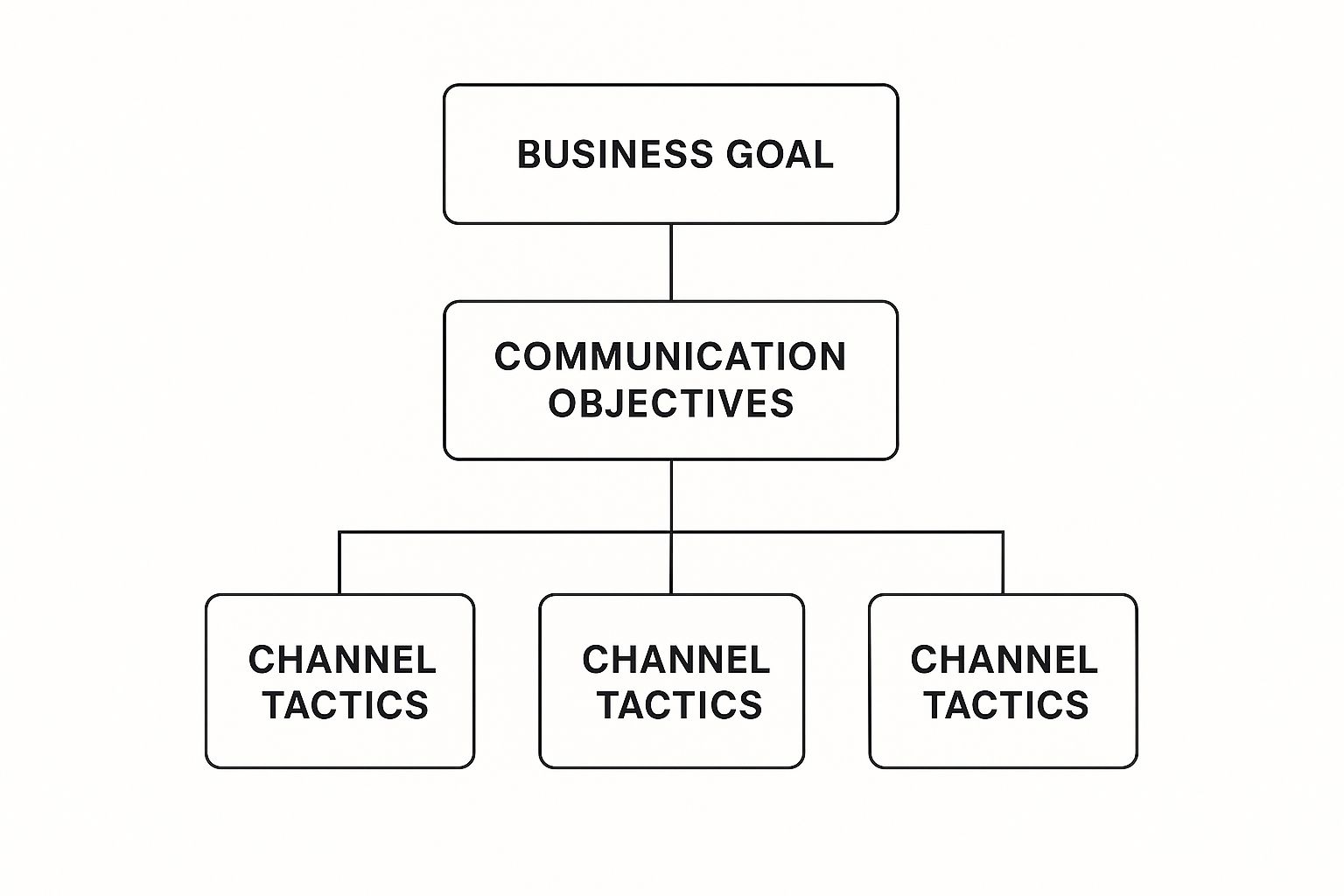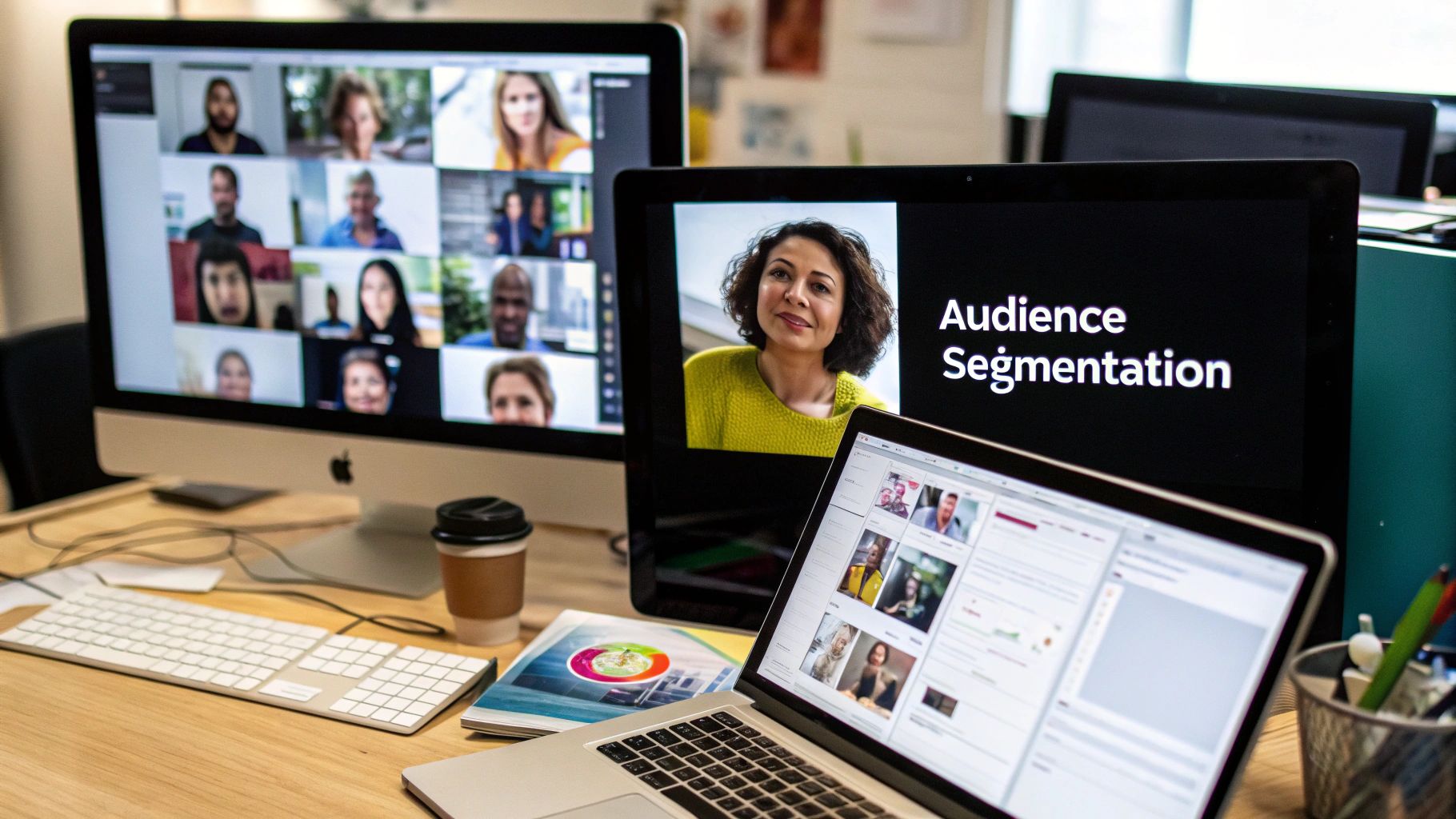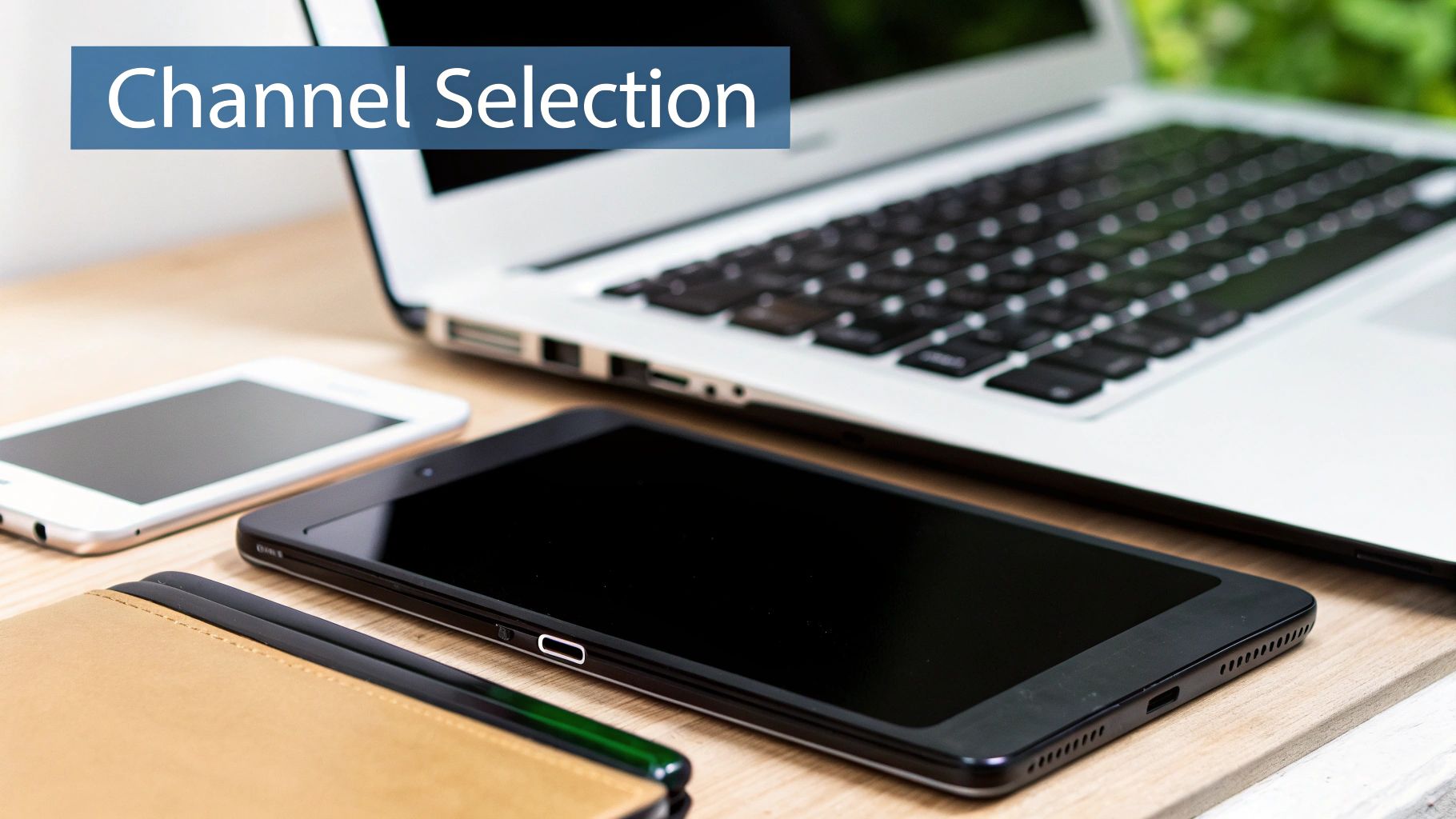A multi-channel communication strategy is all about meeting your customers where they are. Think of it like your favorite local cafe: they might have a sign on the door for walk-ins, send you text alerts for special offers, and maybe even an email newsletter showcasing their new seasonal drinks. You're not forcing customers down one path; you're giving them options. It's about being present on the channels they already use, making it incredibly easy for them to connect with your business.
Let’s get past the textbook definitions. At its heart, a multi-channel communication strategy is about availability and choice. You’re setting up multiple, independent pathways for customers to engage with you. Each channel—whether it's email, social media, or your website's live chat—works on its own. A customer might see your latest post on Facebook but decide to text you later to ask a question.
The key here is that the channels don't necessarily "talk" to each other. They just need to exist and be effective on their own merit. This approach is powerful because it casts a wide net, ensuring your message reaches different types of customers right where they're most comfortable. It’s no surprise that 86% of marketers agree this approach is becoming more effective.
This infographic does a great job of breaking down how a single business goal can translate into specific tactics across various channels.

As the visual shows, every channel you use should directly support a communication objective, which in turn helps you hit a larger business goal.
You've probably heard the terms "multi-channel," "cross-channel," and "omni-channel" thrown around, often as if they mean the same thing. They don't. Understanding these differences is crucial for picking the right approach for your small business. A great example of a specific touchpoint within a channel is a captive portal, which you might encounter on a public Wi-Fi network; fully understanding captive portals helps you see how digital communication works in different contexts.
The primary difference between these strategies lies in how the channels are integrated. Multi-channel focuses on presence, while cross-channel and omni-channel focus on creating a connected customer journey.
To make things crystal clear, let's break down these concepts in a simple table.
This table offers a quick comparison of these three related but distinct communication strategies, highlighting their unique focus and approach to customer interaction.
While a multi-channel approach is an excellent starting point, many businesses eventually evolve their strategy toward greater integration. For a deeper dive into that next level, you might be interested in learning how to boost experiences with an omnichannel communication platform.
For now, though, this guide will focus on mastering the fundamentals of a multi-channel strategy—the foundational step for any small business looking to expand its reach and improve customer interactions.

For a small business, every single customer interaction matters. Adopting a multi-channel communication strategy isn't just some fancy tactic for big corporations; it’s a powerful way for smaller players to build resilience, inspire loyalty, and seriously punch above their weight.
Let's flip the script and think like a customer for a second. If they can ask a question, book an appointment, or get a reminder on whatever app they already have open, their experience is instantly better. This isn't about empty buzzwords—it's about real, measurable results that directly impact your bottom line.
The most immediate win is a huge expansion of your potential customer base. By being active on different platforms, you meet different people where they naturally hang out. Some of your clients live in their email inbox, while others will only ever see a quick text message.
This diversified presence naturally leads to higher engagement. A customer who tunes out a promotional email might be completely captivated by a project photo you post on social media. By offering multiple touchpoints, you dramatically increase the odds of your message not just being seen, but acted upon.
Think about a local contractor:
Consistency is key. When a customer sees the same professional branding and helpful tone on your website, social media, and in their texts, it creates a powerful sense of reliability and trust. In a crowded market, that's how you stand out.
A great customer experience is one of the strongest competitive advantages you can have. Being accessible across multiple platforms shows customers you value their time and are committed to making things easy for them.
This accessibility makes a world of difference. Imagine a potential client trying to reach you. If your phone line is busy, but they can quickly shoot you a text or use a website chat, you’ve just saved a lead that might have gone straight to a competitor.
Even better, you don't have to manage it all manually. For instance, an AI receptionist for small businesses can handle these inquiries across every channel, making sure you never miss an opportunity.
At the end of the day, a well-executed multi-channel strategy translates into concrete business outcomes. When you make it easier for customers to connect with you and make a purchase, you naturally improve your conversion rates.
It all boils down to these key drivers:
This isn't about piling more work onto your plate. It's about working smarter by being present in the right places at the right times. When you do that, you build a more robust, customer-focused business that doesn’t just attract new clients but keeps them for the long haul.

Your customers aren't all in one place, so your business shouldn't be either. But a multi-channel strategy isn't about blasting your message across every platform imaginable—that’s just a fast track to burnout. The real goal is to build a smart, effective mix of channels that puts you exactly where your audience is ready to listen.
Think of it like a toolkit. You wouldn't grab a hammer to turn a screw, right? In the same way, you wouldn't send a long, story-driven update via a quick SMS message. Choosing the right tool for the job makes all the difference.
Even with all the new platforms popping up, email is still a heavyweight champion in business communication. It gives you a direct line to your audience, letting you send detailed, personalized messages that other channels just can't handle.
Email is your go-to for building relationships over time. It’s perfect for:
Best of all, it's your space. You control the narrative without worrying about algorithms or character limits.
When a message absolutely, positively has to be seen right away, nothing beats the power of a text message. With incredibly high open rates, SMS cuts through the digital noise for any time-sensitive alert.
Think of SMS as your channel for high-priority pings. A local auto shop can text a customer the second their car repair is finished, or a salon can send a 24-hour appointment reminder. These quick, actionable messages add a ton of value and make life easier for your customers. When adding texting to your strategy, services that let you rent SMS numbers for communication can be a great way to manage your outreach professionally.
The power of SMS lies in its simplicity and urgency. Use it for communications that require immediate attention, but be careful not to overuse it to avoid being perceived as spam.
Remember, direct access to a customer’s phone is a privilege. Keep your texts short, sweet, and focused on providing clear, instant value.
Platforms like Facebook and Instagram aren't just for running ads. They are buzzing communities where you can show off your brand's personality and connect with customers in a much more casual setting.
These platforms are visual by nature, making them perfect for showing your products or services in action. A landscaping company can post stunning before-and-after photos, while a local bakery can share drool-worthy videos of their latest treats. This visual proof builds trust and desire.
The key is picking the right social platform for your audience. A B2B service might get more traction on LinkedIn, while a fashion boutique will naturally thrive on a visual-first platform like Instagram. Don't feel pressured to be everywhere—just master the one or two platforms where your customers hang out the most.
Your website is your digital storefront, and a live chat feature is like having a helpful salesperson on the floor at all times. It gives visitors an immediate way to get their questions answered without the hassle of making a call or sending an email.
This real-time help can be the difference between a lost visitor and a new customer. It's perfect for answering quick questions about product features, service availability, or shipping policies. Better yet, implementing an AI-powered chat on your site means you can provide this support 24/7, capturing leads and helping customers even when you're closed.
Tying these channels together into one manageable system is a huge advantage. Our guide on the advantages of unified communications dives deeper into how this works.
It’s clear modern marketers understand the power of this blended approach. Research confirms that B2C marketers rely on multiple channels, with email at 82.4% usage leading the way, closely followed by social media and mobile websites. Today, the average marketer uses at least five different channels to run effective campaigns.
Alright, let's turn that AI-generated guide into something that sounds like it came from a real, seasoned expert who's actually helped small businesses get this stuff done.
Here’s the rewritten section:
Putting theory into practice is where the magic happens. A multi-channel strategy isn't some complex corporate plan reserved for the big guys; it’s just a smart, manageable roadmap for your small business. The idea is to take this big, intimidating concept and break it down into simple tasks you can actually start today.
It all boils down to knowing who you're talking to, deciding what you want to achieve, picking the right places to talk, and making sure you always sound like you. Let's walk through it.
Before you even think about which social media platform to post on, you need to know exactly who you're trying to reach. Guessing is the fastest way to waste time and money. Instead, think of yourself as a detective, piecing together clues about your customers' habits.
Start with the data you already have. Your website analytics, social media insights, and any customer lists are goldmines. Look for the simple stuff: How old are your customers? How did they find you? What posts or pages do they seem to love?
Next, just ask them. Seriously. You don’t need a fancy market research firm.
Once you know your audience, you can stop shouting into the void and start having real conversations where it matters most.
A strategy without goals is just a bunch of busywork. You might feel productive, but you won't be moving the needle on what actually matters for your business. Your goals need to be specific, measurable, and tied directly to a real-world result.
Forget vague goals like "improve communication." Get specific. Your goals will be your North Star, guiding every channel you choose and every message you send.
Your goals are what turn random acts of marketing into a coordinated plan. They define what success looks like and give you a way to know if your efforts are actually paying off.
Here are a few examples of strong, measurable goals a small business can use:
Goals like these give you a finish line. You'll know instantly if what you’re doing is working or if it's time to try something else.
Now that you know your audience and your goals, you can finally pick your channels. And here’s a pro tip: the goal isn’t to be everywhere. It's to be on the right channels for your customers. Spreading yourself too thin is a classic mistake that only leads to burnout and mediocre results.
Prioritize the channels where your audience actually hangs out and that make sense for your goals. While some studies show businesses use an average of 10 channels, you don’t need that many. Start with two or three powerful ones and expand later.
A great starting mix for a local service business could be:
This focused approach lets you get really good at a few key channels before you get overwhelmed, ensuring you deliver quality everywhere you show up.
Finally, consistency is the glue that holds your entire strategy together. Your brand's personality—its tone, its style—should feel the same whether someone is reading an email, seeing a social post, or getting a text message from you.
This doesn't mean you copy-and-paste the same message everywhere. It means the vibe is consistent. If you're friendly and casual on social media, don't suddenly switch to sounding like a stuffy lawyer in your emails. It's jarring.
The easiest way to do this is to create some simple brand guidelines. This doesn't need to be a 50-page document. Just a single page that outlines your core message, the tone you're going for (e.g., helpful, professional, witty), and maybe a few words you love to use or want to avoid. This little bit of prep work ensures every interaction builds a single, trustworthy brand identity that keeps customers coming back.

As you can see on the homepage for My AI Front Desk, the promise of this technology is crystal clear: to automatically handle diverse tasks like answering calls and texts, qualifying leads, and scheduling appointments. This kind of centralized AI management is what makes a sophisticated communication strategy practical for any small business.
Putting your communication strategy on autopilot might sound like science fiction, but it's now a daily reality for thousands of small businesses. This is where Artificial Intelligence (AI) comes in—not to replace the human touch, but to amplify it by taking over the repetitive, time-consuming tasks that bog you down.
An AI-powered tool, like My AI Front Desk, acts as a central brain for all your customer conversations. It can seamlessly manage interactions across every channel you use, ensuring no lead falls through the cracks and every customer feels heard, day or night. This makes a sophisticated multi channel communication strategy both efficient and affordable.
Think about how you've traditionally managed customer communications. It usually meant constantly jumping between your email inbox, social media DMs, text messages, and website chat. It was a recipe for missed opportunities and inconsistent service. AI completely flips this dynamic on its head.
Instead of you juggling multiple platforms, an AI assistant becomes your single point of contact, orchestrating conversations behind the scenes. This isn't just about saving time; it's about creating a more reliable and professional customer experience.
Imagine the practical applications for your business:
Managing multiple communication channels can feel like a constant juggling act. But what happens when you introduce an AI-powered assistant? The difference is night and day. Here’s a quick comparison of how AI streamlines tasks that would otherwise drain your time and resources.
As you can see, the AI-powered approach doesn't just save time—it creates a more robust and professional system for your business to operate within. It transforms a chaotic, reactive process into a streamlined, proactive strategy.
This shift toward AI-driven communication isn't a niche trend; it's a massive economic force. The global market for multi-channel marketing hubs was valued at USD 6 billion in 2024 and is projected to grow significantly, largely driven by AI advancements that make true personalization possible.
For small businesses, this technology levels the playing field. You gain the capabilities of a large support team without the overhead, allowing you to deliver exceptional service consistently. The right AI assistant can even intelligently route complex queries to a human team member, ensuring technology and people work together perfectly.
By implementing AI, you free yourself from the role of a switchboard operator and step back into the role of a business owner. It allows you to focus on high-value activities—like building relationships and growing your business—while the AI handles the routine communications that keep things running smoothly. For a more detailed look, check out our complete guide on how AI assistants improve multichannel communication. This smart automation is what makes a modern communication strategy not just possible, but powerful.
Whenever you roll out a new game plan, a few practical questions are bound to pop up. Diving into a multi-channel communication strategy is no different. Let's tackle some of the most common hurdles so you can move forward with confidence.
These questions usually circle back to three things: knowing your audience, managing costs, and proving your efforts are actually paying off. Getting straight answers here will help you make smarter decisions for your business.
The easiest way? Just ask them. You don't need a huge research budget for this. Something as simple as a poll on your social media pages or adding a "How did you hear about us?" field to your website's contact form can give you incredible direction.
Next, dig into the data you already have. Your website analytics and social media insights are goldmines. They tell you where your audience is coming from and what they engage with. Pay attention to demographics—younger crowds might be all over Instagram, while professional clients probably stick to LinkedIn and email. The goal is to collect clues, not just make assumptions.
Not at all. The beauty of a multi-channel communication strategy is that it’s completely scalable. You can start with free or low-cost channels that give you a high return on your time, like a Google Business Profile, a Facebook page, and a basic email newsletter. The key is to be on the right channels, not all of them.
The real cost isn’t in the strategy; it’s in the missed opportunities from being invisible to potential customers. Being accessible where they already are is an investment in growth, not just an expense.
Plus, modern tools bundle services, making a professional multi-channel setup way more affordable than you might think. An AI-powered system can manage multiple channels for a fraction of what it would cost to hire dedicated staff.
You measure what matters. If your goal was to slash no-shows, track that specific number after you start sending SMS reminders. If you wanted more leads, count the inquiries coming from each channel. Turn your abstract goals into concrete numbers by focusing on key metrics.
Keep an eye on numbers like:
Most modern marketing tools come with simple dashboards that make tracking these things a breeze. It's how you turn guesswork into a clear, data-driven plan for success.
Ready to stop juggling and start connecting? The My AI Front Desk can manage your calls, texts, and emails 24/7, ensuring you never miss a lead. See how our AI receptionist can automate your communication and drive revenue today.
Start your free trial for My AI Front Desk today, it takes minutes to setup!








